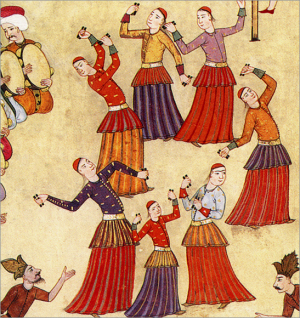(Boylove Documentary Sourcebook) - A British Travel Account Regarding the Male Dancers Performing at the 1675 Ottoman Imperial Festivities Held by Sultan Mehmed IV in Adrianople

From the expurgated printed version of "Dr. John Covel's Diary" (1670–1679), in Early Voyages and Travels in the Levant, edited, with an introduction and notes, by James Theodore Bent (London: Hakluyt Society, 1893).
Now for the dances and sports. You must understand that from all parts of the Empire were summon’d all (his subjects), Jewes, Greekes, Arabs, Armenians, Turkes, etc., that were any wayes excellent for any sports or entertainments of delight, and truly I do not believe these Eastern Countryes can afford any thing more in that kind then what I have seen here. First, your dancers were for the most part young youths, very handsome generally; most Greekes, yet some more Turkes, Armenians, and a few Jewes.
The best were clothed very rich, either cloth of gold, silver, or rich silk. They had on a just a corp, as we say, coming to mid thigh, close button’d at the hands, and girt about them with rich girdles as their purse and fancy led them; under it (over the rest of their cloth’s) they had a petticoat, which was very large, and hang’d very full, down to their ankles; this was very rich, and of some pretty light merry colour. These clothes were given them by the G. Sr., or Sultana. Their heads are not shaven quite close, but very lovely locks are left round, which at other times they wear up close, and are unseen; but now they let them down, and set them out to best advantage, sometimes disshevel’d all about their shoulders, sometimes braided and hanging at their back. They commonly wore over their hair a plain cap of silk (small, or scull fashion’d) or (which is more gentele) a fur’d sort of cap, cal’d here a culpáck. There was a delicate lovely boy, of about 10 yeares old, had as comely head of hair, long as most women. With him danc’t a lusty handsome man (about 25), both Turkes. They acceded all the roguish lascivious postures conceivable with that strange ingenuity of silent ribaldry, as I protest I believe Sardanapalus and all the effeminate courts of the East never came near them. They pleased so extremely that there was scarce a night but they acted in some place or other. I saw them severall times before the Sultana doe as much as anywhere else.

See also
- Bacha bazi
- Adult friend (dictionary)
- Age of attraction (dictionary)
- Boylove
- Ephebophilia
- Ghilman
- Loved boy (dictionary)
- Minor-attracted person (dictionary)
- Pederasty in the Middle East and Central Asia
- Pedophilia
- Situational homosexuality (dictionary)
- Sufism
- Tellak
- Young friend (dictionary)